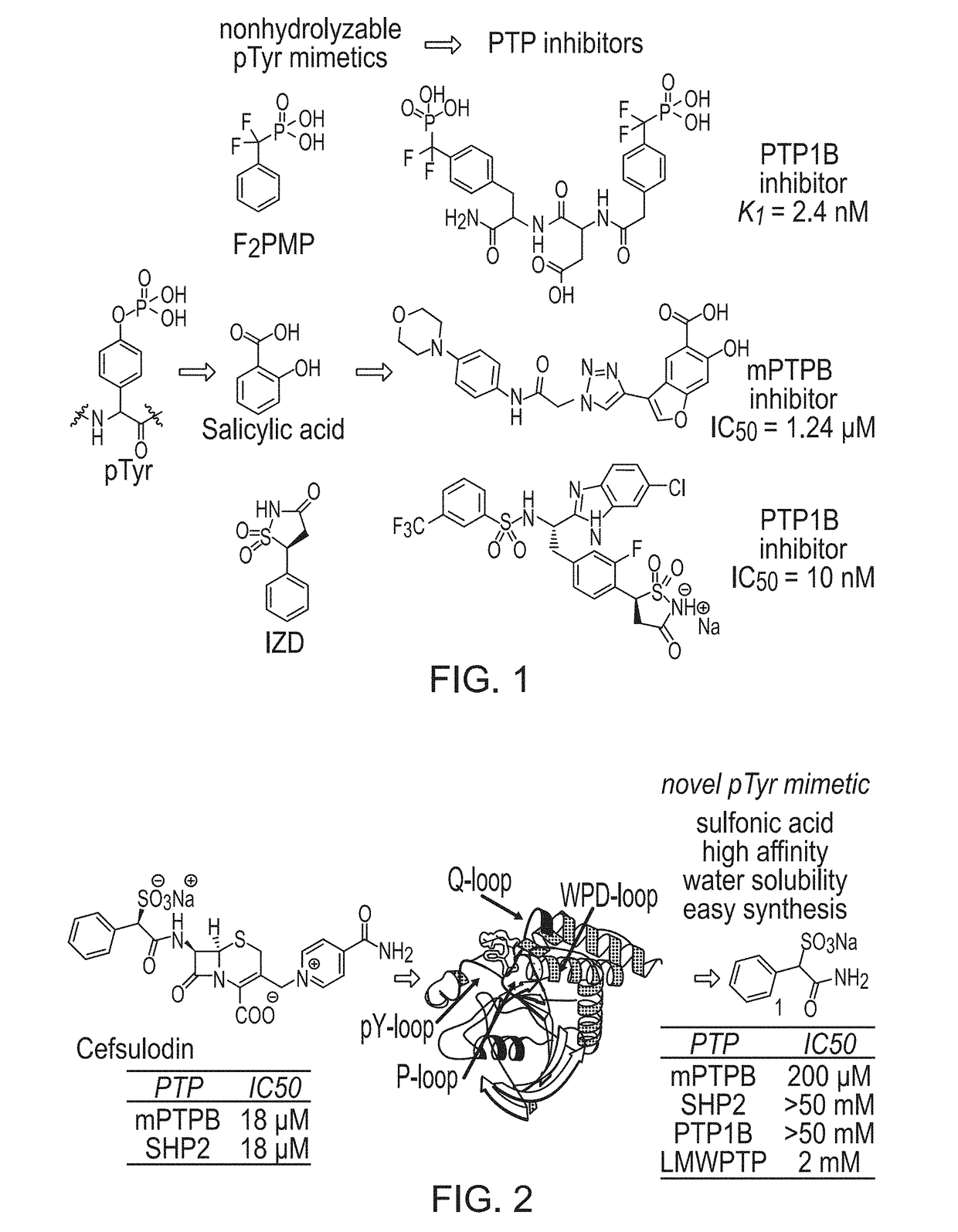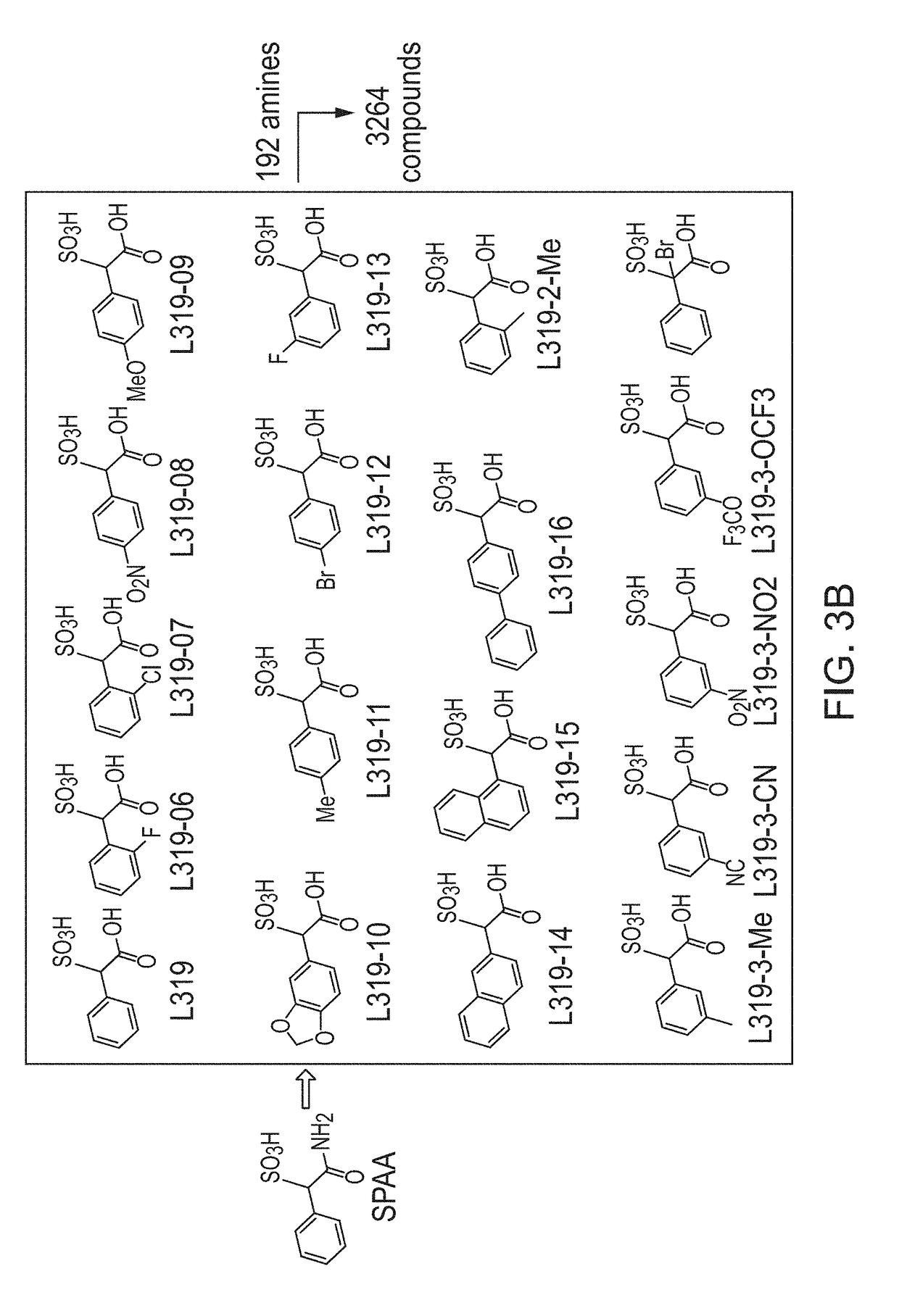Protein tyrosine phosphatases or shp2 inhibitors and uses thereof
a technology of protein tyrosine phosphatases and inhibitors, which is applied in the direction of antibacterial agents, drug compositions, metabolic disorders, etc., can solve the problems of few mptpa inhibitors, time-consuming, tedious and costly, and lack of potency and specificity of mptpa inhibitors
- Summary
- Abstract
- Description
- Claims
- Application Information
AI Technical Summary
Benefits of technology
Problems solved by technology
Method used
Image
Examples
example 1
[0119]Construction of SPAA Based Focused Library.
[0120]Previously, cefsulodin (a β-lactam antibiotics, structure shown in FIG. 2) was identified as an inhibitor of mPTPB. The crystal structure of SHP2-cefsulodin complex shows that sulfonic acid is in close proximity with the PTP signature motif, the α-phenyl group forms a π-π interaction with P loop residue Phe, indicating the nature of SPAA as pTyr mimetic (FIG. 2). Without being bound by any theory, it is believed that SPAA is completely different from conventional pTyr mimetics (such as F2PMP, salicylic acid, etc.), in which the acid group and additional fragment are located on opposite sides of the benzene ring (FIG. 1). For SPAA, however, the additional fragment needs to be extended from the same side of the benzene ring as the acid group. This would have been considered as a disruption to the binding due to the valley shape of the PTP active site, thus would have been avoided during the design of a conventional PTP inhibitor.
[...
example 2
[0124]Potent and Specific Inhibition of mPTPB.
[0125]SPAA based compounds from the libraries were studied as inhibitors against mPTPB, a virulence factor of Mtb strain and a novel drug target of tuberculosis (TB).
[0126]Compound L319N47 demonstrated an IC50 of 9 nM against mPTPB, a 2000-fold increase in potency compared to SPAA, (Tables 1 and 9). L319N47 also demonstrated a 1000-fold preference for mPTPB over mPTPA (IC50=11.3 μM) and a greater than 2000-fold preference for mPTPB over 30 other PTPs (e.g. LMWPTP, IC50=115 μM), including cytosolic PTPs, PTP1B, TC-PTP, SHP2, Lyp and FAPI, the receptor-like PTPs, CD45, LAR, and PTPa, the dual specificity phosphatases VHR, VHX, CDC14A, and the LMWPTP.
[0127]L319N46 and L319N53 (IC50=60 and 20 nM, respectively) were slightly less active than L319N47. However, they demonstrated even higher specificity towards mPTPB. For example, L319N53 exhibited a greater than 10000-fold selectivity over any PTP tested. It is believed that any previously repo...
example 3
[0129]General Procedures for the Preparation of Inhibitors.
[0130]Reagents were used as purchased from Sigma-Aldrich and Fisher Scientific. 1H and 13C NMR spectra were obtained on a BrukerAvance II 500 MHz NMR spectrometer with tetrame-thylsilane or residual solvent as standard. Mass spectra were obtained using an Agilent Technologies 6130 quadrupole LC / MS. HPLC purification was carried out on a Waters Delta 600 equipped with a Sunfire Prep C18 OBD column (30 mm / 150 mm, 5 μm) with methanol-water (both containing 0.1% TFA) as the mobile phase (gradient: 50-100% methanol, flow 10 mL / min). The purity of all final tested compounds was established to be >95% by Agilent Technologies 6130 quadrupole LC / MS by using methanol-water (both containing 0.1% TFA) as the mobile phase (gradient: 0-100% methanol, flow 1.0 mL / min), with UV monitoring at the fixed wavelength of 254 nm.
[0131]Synthesis of L335-M34 (mPTPA).
[0132]To a round-bottom flask were added sulfoacetic acid (0.14 g, 1.0 mmol), DMF (5...
PUM
| Property | Measurement | Unit |
|---|---|---|
| ionic strength | aaaaa | aaaaa |
| ionic strength | aaaaa | aaaaa |
| ionic strength | aaaaa | aaaaa |
Abstract
Description
Claims
Application Information
 Login to View More
Login to View More - R&D
- Intellectual Property
- Life Sciences
- Materials
- Tech Scout
- Unparalleled Data Quality
- Higher Quality Content
- 60% Fewer Hallucinations
Browse by: Latest US Patents, China's latest patents, Technical Efficacy Thesaurus, Application Domain, Technology Topic, Popular Technical Reports.
© 2025 PatSnap. All rights reserved.Legal|Privacy policy|Modern Slavery Act Transparency Statement|Sitemap|About US| Contact US: help@patsnap.com



